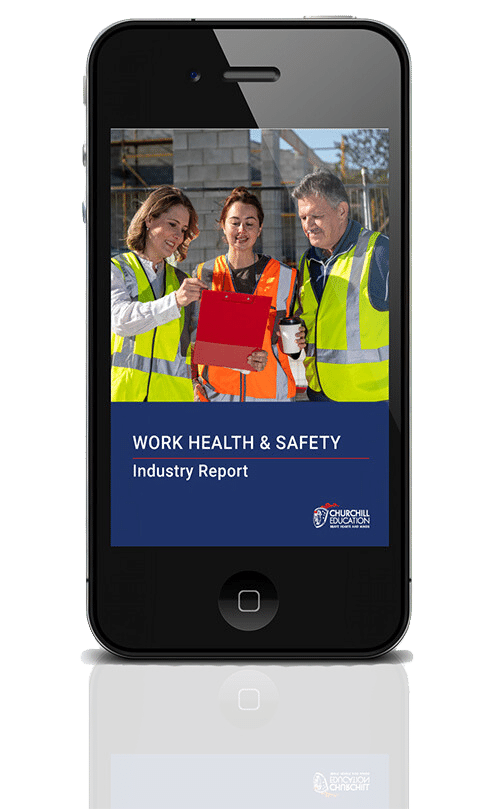Work Health and Safety
Churchill Education specialises in delivering Work Health & Safety qualifications through Recognition of Prior Learning (RPL). Turn your experience, skills and knowledge into a nationally recognised qualification.
Work Health and Safety Qualifications
Industry / Careers / Qualifications
The Australian government website www.business.gov.au defines Work Health and Safety (WHS) as ‘managing the risks to the health and safety of everyone in your workplace including your workers, customers, visitors, and suppliers.’
Safe Work Australia develops policy for WHS and workers’ compensation to improve standards across the country which is then regulated and enforced by each state or territory.
WHS roles within any organisation are of primary importance since work health and safety impacts both the productivity and welfare of every individual.
Tasks and duties include.
- Promoting healthy and safe working methods and practices in the workplace.
- Ensuring state-of-the-art health and safety compliance across the whole organisation.
- Identifying, recording, and reporting hazards, accidents, injuries, and health issues.
- Assisting with investigation of accidents, studying possible causes and providing remedial advice.
- Conducting health and safety training sessions for management, supervisors, and workers.
- Assisting with rehabilitation of workers after accidents and overseeing their successful return to work.
- Coordinating emergency procedures and first aid crews.
- Developing OHS plans and monitoring compliance.
- Inspecting workplace and related tools and equipment to ensure compliance with regulations.
Organisations are also now bound by new legislation regarding psychosocial hazards in the workplace based on the International Standard ISO45003 which aims to protect the emotional wellbeing of the employee at work. This awareness has resulted in many new and exciting career opportunities within the WHS sector. Whilst WHS are responsibilities are relevant and required across all industries, roles are most commonly advertised in these sectors/industries:
- Civil Construction
- Building Construction
- Mining
- Oil & Gas
- Engineering
- Heavy Industry
- Transport
- Government
- Agriculture
Industry Report
IBIS World.com list the industry to be worth approximately $2.3 billion and employees close to 14500 workers across the country.
Seek.com.au puts the salary range of a WHS Officer between $80 000 and $100 000 whilst a WHS Manager at a range between $140 000 and $160 000. It also predicts an industry wide growth of 15.9% over the next 5 years.
WorkSafe Australia showed that 127 800 serious workers compensation claims were made in 2021-2022 with a median compensation paid of almost $16 000 costing industry $2.1 billion across the country, let alone the cost to lost productivity.
Sadly, in 2023 we lost over 170 people to workplace incidents. That’s 170 families whose loved one did not return from work, and exponentially more family, friends and colleagues who will be affected by the ongoing grief of loss.
“Work-related injuries, illnesses, and deaths impose cost on employees, works, and the community. These include both direct and indirect costs.
Direct cost includes items such as workers’ compensation premiums paid by employers or payments to injured or incapacitated workers enforce by each state or territory.
Indirect costs include items such as lost productivity, loss of current and future earnings, lost potential output and the cost of providing social welfare programs for injured or incapacitated workers.
‘Workers bear the brunt of these injuries personally – sitting at around 77% of the cost. The community picks up 18% and employers come in at 5%.
WHS Skills & Qualifications
There is no mandated minimum qualification to enter the WHS sector. However, WHS job advertisements largely require the successful applicant to hold formal qualifications in Work Health and Safety, regardless of the level of the role.
In practice, the entry level standard of qualification is Certificate IV in Work Health and Safety.
Our WHS Qualifications Include:
When it comes to soft skills, there is a focus on these qualities in the WHS field:
Communication skills – you need to be able to tailor your communication, whether in writing or speaking, to your audience and be persuasive. Achieving WHS outcomes is always a team result so it is important you can influence others in achieving the best WHS outcomes.
Collaboration – this is where you have the ability to work effectively with a team. Listening is an important feature of collaborating, as is negotiating.
Analytical thinking – not only do you need to be able to learn legal, technical and regulatory information, you have to be able to analyse it and apply it to a real working environment.
Relevant work experience – the focus on qualifications in job advertisements is also combined with a requirement of experience in the sector. As a general rule, for Diploma equivalent positions, five years’ experience is consistently mentioned as a minimum standard.
Leadership – change is often required in order to maintain the highest standards of workplace health and safety, and this requires leadership in managing change cycles.
Prioritise own work commitments with the team objectives – self-management is vital in an operating environment where deadlines and audit timelines are common.
Attention to detail – in these roles, the small details can have just as a big an impact on workplace health and safety as the larger objectives.
Technological literacy – as technology continues to offer more to workplaces, it is important that you can use common computer programs and technological tools in WHS and interpret reports.
Anecdotally, physical fitness seems standard in people successful in this field – after all, this work focuses on health too. It would be wise to hold a Senior First Aid certificate and a current drivers’ licence too.
Certificate IV in Work Health & Safety
This is a standard level of training for safety officers. It is comprised of 10 units of competency – five of which are core units (or compulsory) and five elective units (which allows some range to match your experience or interests to particular units). There are no pre-requisites to enrol in the Certificate IV in Work Health and Safety.
Examples of Position Titles relevant to Certificate IV level work:
- Work Health and Safety advisor
- Health Safety & Environment (HSE) Advisor
- WHS Officer
- WHS Coordinator
- HSE Coordinator
- Safety Health & Wellbeing Officer
What is the Difference between the Certificate IV and Diploma?
At Certificate IV level, you are relatively young in your Work Health and Safety career. On a day to day basis, you work under limited supervision, identifying risks and you may provide some guidance to others relating to Work Health and Safety matters. You are maintaining a WHS system, often in a workplace rather than being necessarily in a Work Health and Safety industry specifically.
You have the technical skills and can deal with the facts in front of you, heading to your supervisor for more direction when you need it. The successful candidate will be required to maintain the company’s safety management system, implement policies, strategies and operating procedures that support prevention of incidents in accordance with relevant legislation.
This can mean completing checks of WHS management systems and reviewing the results. From there, someone working at Certificate IV level can be required to analyse the results and reporting the outcome up the chain to your supervisor.
At Diploma level, you are going to be responsible for a team and giving direction about the WHS practices in your workplace. When complex problems present, you will be the person tasked with considering them and ensuring an effective resolution as you design and continuously improve a WHS system.
Typically, people who are operating at a Diploma level in a WHS role have in-depth experience that has been progressively built up in the industry, giving them a substantial knowledge base to draw upon.
Diploma of Work Health & Safety
To complete the Diploma of Work Health and Safety through Recognition of Prior Learning (RPL), you need to demonstrate that you have the skills and knowledge to manage risks (including identifying hazards), manage legal responsibilities in a WHS context, and investigate and report on health and safety incidents.
At the Diploma level, you are also educating and leading initiatives to improve health and safety measures in the workplace. There is a focus on your communication skills, analytical abilities to resolve complex WHS problems and using your best judgement to make decisions. You will have people who report to you on WHS issues and look to you for direction and resolutions.
To be eligible to enrol in the Diploma of Work Health and Safety you need to have the five core units from the Certificate IV in Work Health and Safety. You can have older versions of these units provided they have been deemed equivalent. Alternatively, you can gain these through Recognition of Prior Learning. Once these units have been assessed and a Statement of Attainment issued, you can enrol in and be assessed for the Diploma.
Units of Competency
The Diploma of Work Health and Safety has nine units of competency, five of which are core (or mandatory) units, and four elective units.
Core units address:
- Management across WHS consultations
- Systematic management of WHS risks
- WHS incident investigations
- Developing, implementing and maintaining systems that manage WHS in the workplace.
- Environmental Health Officer
- OHS Adviser, Coordinator or Officer
- WHS Adviser, Coordinator or Officer
- WHS Manager
- Health & Safety Training Officer
- Health Safety & Environment (HSE) Advisor
- HSE Coordinator
- HSE Superintendent
- HSE Manager
- Safety, Health & Wellbeing Advisor
- Health, Safety, Environment & Training Coordinator
- Health, Safety, Environment & Quality Manager
- Health, Safety & Wellbeing Manager
- Occupational Health & Safety Project Officer
- Coordinator, Safety
- Occupational Hygienist
- Workplace Rehabilitation Officer
What is the Difference between the Diploma and Advanced Diploma?
When looking at Diploma level work, a key starting point is that the WHS worker is following the systems, policies and processes that an organisation already has in place. Execution at Diploma level involves identifying risks, consulting, and investigating incidents.
For example, at a Diploma level, you can be completing investigations into WHS incidents and you present your findings and recommendations to your supervisor. A supervisor’s consideration of what is required in response to a WHS incident will be operating at an Advanced Diploma level of strategic analysis.
At the Advanced Diploma level, the responsibility is to create the Work Health and Safety approach that protects the working environment. The Advanced Diploma leads through evaluating the WHS systems, policies and procedures and implementing the activities that the Diploma level workers will be executing.
Advanced Diploma of Work Health & Safety
To enrol in the Advanced Diploma of Work Health and Safety, you must hold all the core units from Diploma of Work Health and Safety or equivalent competencies.
There are eight units of competency in the Advanced Diploma of Work Health and Safety, of which there are five core units of competency (mandatory units) and three elective units of competency.
Examples of Position Titles relevant to Advanced Diploma level work:
- WHS Practitioner
- HR Practitioner
- WHS Manager
- HSE Manager
- Senior HSE Advisor
- Work Health and Safety Auditor
- Work Health and Safety Manager
- Work Health and Safety Specialist
- Senior Consultant – WHS and Risk Management
If you are operating at an Advanced Diploma level, you will have these key responsibilities of a WHS leader at a strategic level (mirroring the core units of the Advanced Diploma):
- Creating the WHS framework for the organisation
- Strategic planning and management
- Guiding best practice
- Expect leadership abilities
The core units cover these areas in WHS management:
- You are applying legislative frameworks for Work Health and Safety (which by necessity involves interpreting legislation and determining how that works in practice).
- WHS management systems are developed, implemented and maintained on an ongoing basis
- Coordinating and facilitating WHS activities, giving strategic consideration to consulting and gaining buy-in from stakeholders and other WHS professionals.
- Implementing risk management strategies addressing WHS risks.
- Evaluating the overall performance of organisations in Work Health and Safety.
In addition to roles that hold clearly focused WHS positions, you will also see professionals in these fields gaining Advanced Diplomas of Work Health and Safety:
- WHS Consultants who come into an organisation to offer WHS advice and who need to have their skills and knowledge independently verified.
- Human Resource Management specialists who are building or reflecting their specialised knowledge in WHS.
- Upper management who need to understand more about WHS responsibilities and work closely with WHS divisions.
Using RPL qualifications as credit towards university studies:
Many people who have gained qualifications with Churchill Education have used them to gain credit towards further education, including Bachelor degrees or Masters at university. All nationally recognised qualifications can be used for credit transfer. Most universities state that the amount of credit granted depends on the specific application of an individual.
What Other Qualifications Complement a WHS Career?
It makes sense that a career in Work Health and Safety focuses on acquiring Work Health and Safety qualifications. But what other qualifications are also valued in this field?
In preparing this report, we spent considerable time reviewing online job advertisements and position descriptions to see what other skills and qualifications employers are looking for.
The specialist complementary skills and qualifications we often found mentioned were:
- Leadership and Management skills
- Quality Auditing qualifications
- Security and Risk Management qualifications
- Human Resources qualifications
- Incident Investigation qualifications
From there, it helps to align the qualifications to a similar level that sits with your Work Health and Safety qualification.
Certificate IV Level
For WHS positions in business and people management:
For WHS positions requiring specialist/technical skills:
Diploma Level
If you are at Diploma level in Work Health and Safety, then you could consider adding some academic recognition of your skills and knowledge in one or more of the following qualifications:
For WHS positions in business and people management:
For WHS positions requiring specialist / technical skills:
Advanced Diploma Level
If you are at Advanced Diploma level in Work Health and Safety, then you should consider adding some academic recognition of your skills and knowledge in one or more of the following qualifications:
For WHS positions in business and people management:
Graduate Reviews










